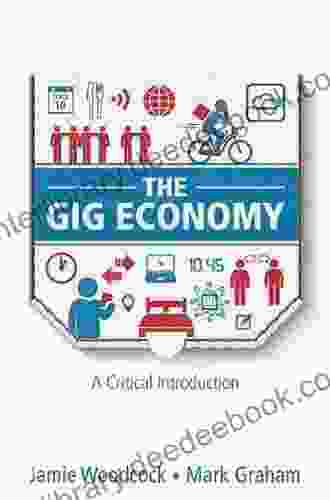The Gig Economy: A Comprehensive Introduction

The gig economy is a transformative force in the modern workplace, characterized by the proliferation of short-term, task-based work arrangements. Unlike traditional employment models where individuals are hired full-time or part-time as employees, the gig economy empowers workers to engage in freelance, contract, or on-demand work for multiple clients or companies.
4.3 out of 5
| Language | : | English |
| File size | : | 1358 KB |
| Text-to-Speech | : | Enabled |
| Screen Reader | : | Supported |
| Enhanced typesetting | : | Enabled |
| Word Wise | : | Enabled |
| Print length | : | 178 pages |
| Lending | : | Enabled |
This article aims to provide a comprehensive to the gig economy, examining its background, key characteristics, types, advantages, disadvantages, and implications for the workforce.
Historical Background
The concept of the gig economy has its roots in the freelance and temporary work arrangements that have existed for centuries. However, the advent of digital platforms and internet-enabled technologies has significantly accelerated the growth and scale of the gig economy.
Platforms such as Uber, Lyft, TaskRabbit, and Fiverr have played a pivotal role in connecting individuals with task-based work opportunities. These platforms offer flexibility, convenience, and access to a wider pool of workers for businesses and clients.
Key Characteristics of the Gig Economy
- Short-term and task-based work: Gig workers typically engage in specific tasks or projects rather than long-term employment relationships.
- Flexibility and autonomy: Gig workers have the flexibility to choose their work hours, projects, and clients, allowing them to balance work with personal commitments.
- Independent contractors: Gig workers are generally classified as independent contractors rather than employees, meaning they are responsible for their own taxes, insurance, and benefits.
- Platform-mediated work: Many gig workers find work through online platforms that connect them with potential clients or companies.
- Contingent workforce: Gig workers often form part of a contingent workforce, providing temporary or project-based support to businesses without the need for full-time employment.
Types of Gig Work
The gig economy encompasses a diverse range of work types, including:
- Freelance work: Individuals offer their skills and expertise on a project-by-project basis, such as writing, graphic design, or web development.
- Contract work: Individuals are hired for specific projects or tasks with a defined scope and duration.
- On-demand work: Individuals perform tasks or provide services on an as-needed basis, such as ride-sharing, delivery, or customer support.
- Task-based work: Individuals complete specific tasks, such as data entry, transcription, or image annotation.
- Gig work platforms: Online platforms that connect gig workers with clients or companies, offering a variety of task-based work opportunities.
Advantages of the Gig Economy
The gig economy offers several advantages for individuals and businesses:
- Flexibility and autonomy: Gig workers enjoy the flexibility to set their own schedules, choose their projects, and balance work with personal life.
- Earning potential: Gig work can provide supplemental income or even replace traditional employment, offering earning potential based on skills and effort.
- Skill development: Gig work opportunities allow individuals to expand their skillset, gain new experiences, and enhance their employability.
- Access to work: The gig economy provides work opportunities for individuals who may face barriers to traditional employment, such as students, caregivers, or those with disabilities.
- Business cost savings: Businesses can save costs by hiring gig workers for specific projects or tasks rather than hiring full-time employees.
Disadvantages of the Gig Economy
Despite its advantages, the gig economy also presents some challenges:
- Income instability: Gig work can be unpredictable, and income may fluctuate depending on the availability of work and client demand.
- Lack of benefits: As independent contractors, gig workers are not eligible for traditional employee benefits such as health insurance, paid time off, or retirement savings.
- Job security and rights: Gig workers may have limited job security and may not have the same rights and protections as traditional employees.
- Competition: The gig economy is highly competitive, and workers may face intense competition for projects or tasks.
- Exploitation: Some gig work platforms have been criticized for exploiting workers by offering low pay, few benefits, and limited opportunities for advancement.
Impact on the Workforce
The gig economy has significant implications for the workforce:
- Changing nature of work: The gig economy has contributed to the trend towards more flexible and contingent work arrangements, leading to a decline in traditional long-term employment.
- Polarization of the workforce: The gig economy may exacerbate the polarization of the workforce, with high-skilled gig workers benefiting from increased opportunities while low-skilled workers may face challenges competing in the gig economy.
- Gig economy workers as a vulnerable population: Gig economy workers often face challenges such as income instability, lack of benefits, and job insecurity, making them a vulnerable population in the labor market.
- Need for regulation and protection: The growth of the gig economy has raised concerns about the need for regulation to protect gig workers' rights and ensure fair labor practices.
- Future of work: The gig economy is part of a broader shift towards more flexible and decentralized work models, shaping the future of work.
The gig economy is a complex and rapidly evolving phenomenon that presents both opportunities and challenges for individuals and businesses. While it offers flexibility, earning potential, and skill development opportunities, it also raises concerns about income instability, lack of benefits, and worker exploitation.
Understanding the gig economy, its characteristics, and implications is crucial for policymakers, businesses, and workers alike. As the gig economy continues to expand, there is a need for ongoing research, dialogue, and policy debates to ensure fair labor practices, protect vulnerable workers, and optimize the benefits of this transformative work model.
4.3 out of 5
| Language | : | English |
| File size | : | 1358 KB |
| Text-to-Speech | : | Enabled |
| Screen Reader | : | Supported |
| Enhanced typesetting | : | Enabled |
| Word Wise | : | Enabled |
| Print length | : | 178 pages |
| Lending | : | Enabled |
Do you want to contribute by writing guest posts on this blog?
Please contact us and send us a resume of previous articles that you have written.
 Book
Book Page
Page Chapter
Chapter Text
Text Story
Story Genre
Genre Reader
Reader Library
Library Paperback
Paperback E-book
E-book Newspaper
Newspaper Paragraph
Paragraph Shelf
Shelf Bibliography
Bibliography Synopsis
Synopsis Footnote
Footnote Classics
Classics Library card
Library card Narrative
Narrative Biography
Biography Autobiography
Autobiography Memoir
Memoir Reference
Reference Narrator
Narrator Character
Character Borrowing
Borrowing Archives
Archives Study
Study Research
Research Lending
Lending Academic
Academic Journals
Journals Reading Room
Reading Room Rare Books
Rare Books Special Collections
Special Collections Literacy
Literacy Storytelling
Storytelling Awards
Awards Reading List
Reading List Theory
Theory Stacy Horn
Stacy Horn Theresa Ward
Theresa Ward Dinesh D Souza
Dinesh D Souza Jack Finney
Jack Finney Brenda Felber
Brenda Felber Jenna Arnold
Jenna Arnold Merita S Whatley
Merita S Whatley Sheng Yen
Sheng Yen Ieva Ozolina
Ieva Ozolina Akinwumi Ogundiran
Akinwumi Ogundiran April Peter
April Peter Brenna Yovanoff
Brenna Yovanoff Benjamin Netanyahu
Benjamin Netanyahu John A Murley
John A Murley Christopher Marsh
Christopher Marsh Ada Petrova
Ada Petrova Frank Tallis
Frank Tallis Herbert Strang
Herbert Strang J E Murphy
J E Murphy Jean Reidy
Jean Reidy
Light bulbAdvertise smarter! Our strategic ad space ensures maximum exposure. Reserve your spot today!

 Harry CookLessons in Leadership: Exploring the Essential Attributes and Strategies for...
Harry CookLessons in Leadership: Exploring the Essential Attributes and Strategies for... E.M. ForsterFollow ·12.3k
E.M. ForsterFollow ·12.3k Danny SimmonsFollow ·18.3k
Danny SimmonsFollow ·18.3k Hunter MitchellFollow ·12.8k
Hunter MitchellFollow ·12.8k Jared PowellFollow ·2.1k
Jared PowellFollow ·2.1k Giovanni MitchellFollow ·16.1k
Giovanni MitchellFollow ·16.1k Abe MitchellFollow ·2.4k
Abe MitchellFollow ·2.4k Preston SimmonsFollow ·9.7k
Preston SimmonsFollow ·9.7k Raymond ChandlerFollow ·18.1k
Raymond ChandlerFollow ·18.1k

 Bo Cox
Bo CoxDiscover the Enchanting Allure of Collingwood, Ontario,...
Nestled amidst the breathtaking landscape of...

 Ralph Ellison
Ralph EllisonThe Street of Clocks Poems: A Poetic Journey Through Time
Welcome to The Street...

 Dwight Blair
Dwight BlairCritical Political Economy of the Middle East and North...
The Middle East and...

 Deion Simmons
Deion SimmonsPerfect Strategies For Painting Amazing Marine Creatures...
Gouache is a...

 Hugh Bell
Hugh BellThe American Republic: Constitution, Tendencies, and...
The American Republic,...
4.3 out of 5
| Language | : | English |
| File size | : | 1358 KB |
| Text-to-Speech | : | Enabled |
| Screen Reader | : | Supported |
| Enhanced typesetting | : | Enabled |
| Word Wise | : | Enabled |
| Print length | : | 178 pages |
| Lending | : | Enabled |












